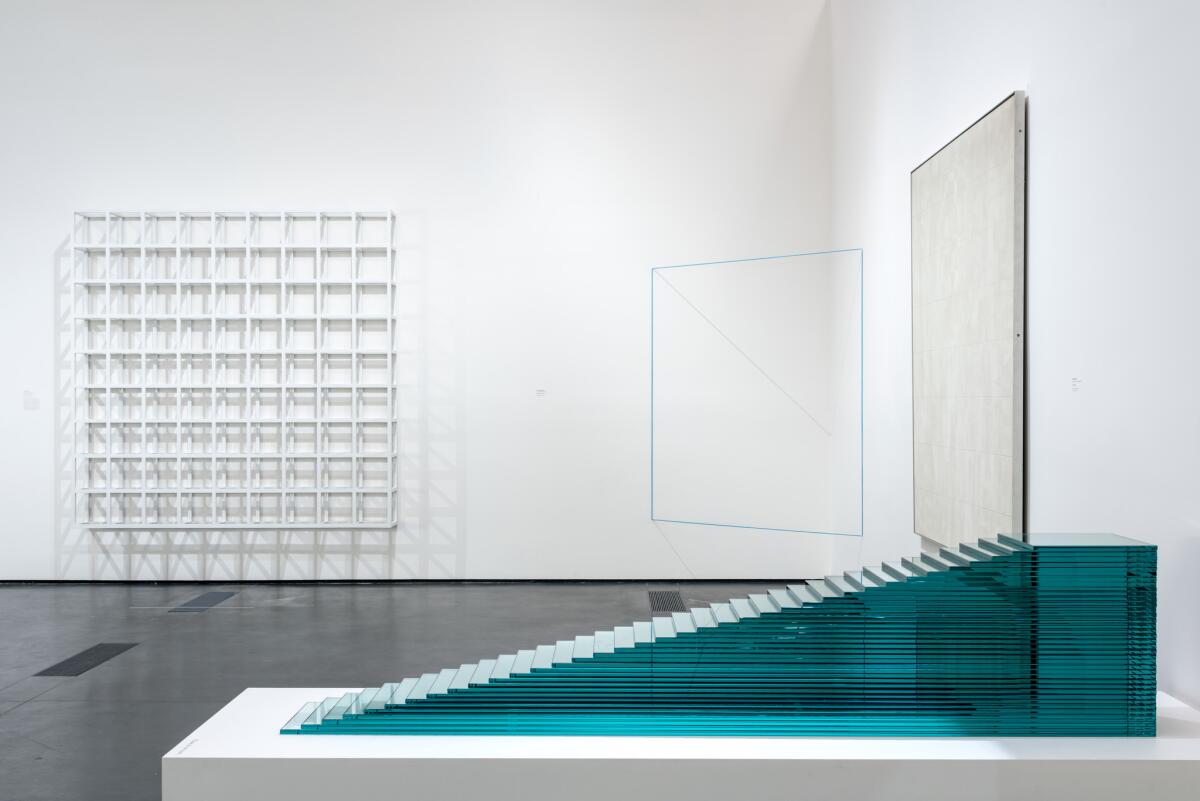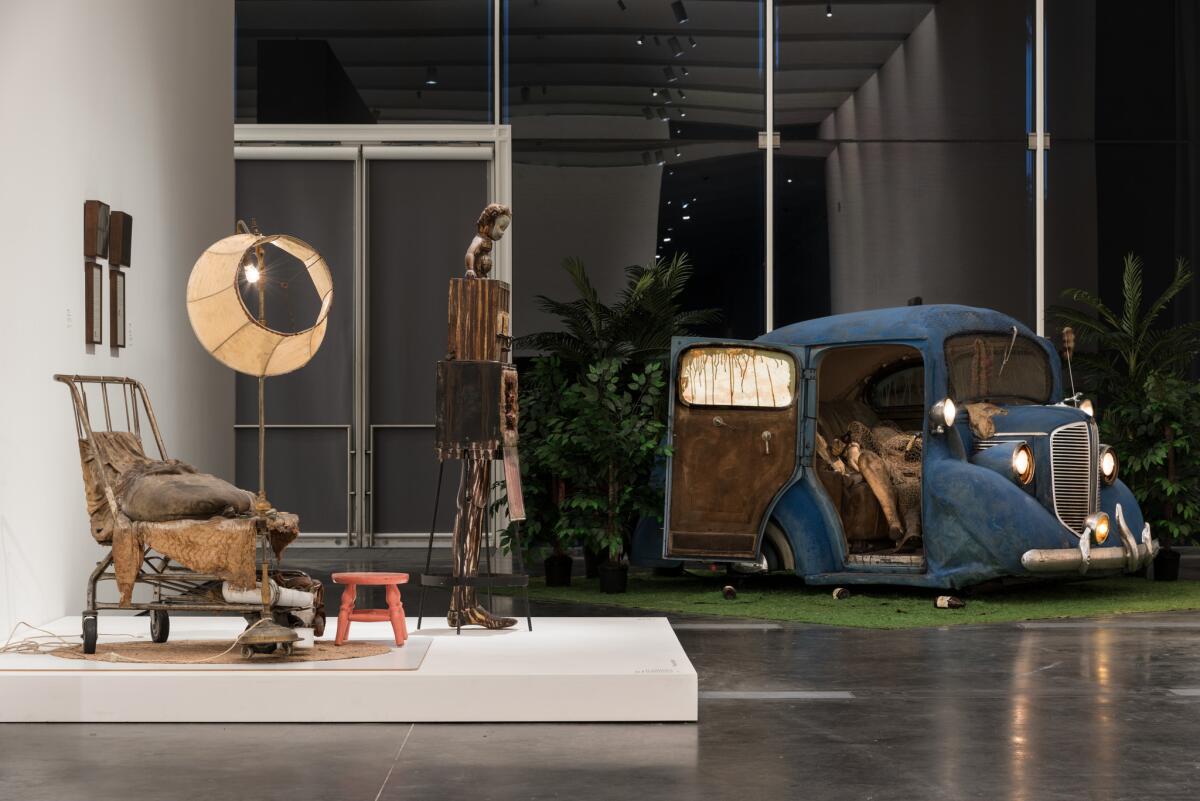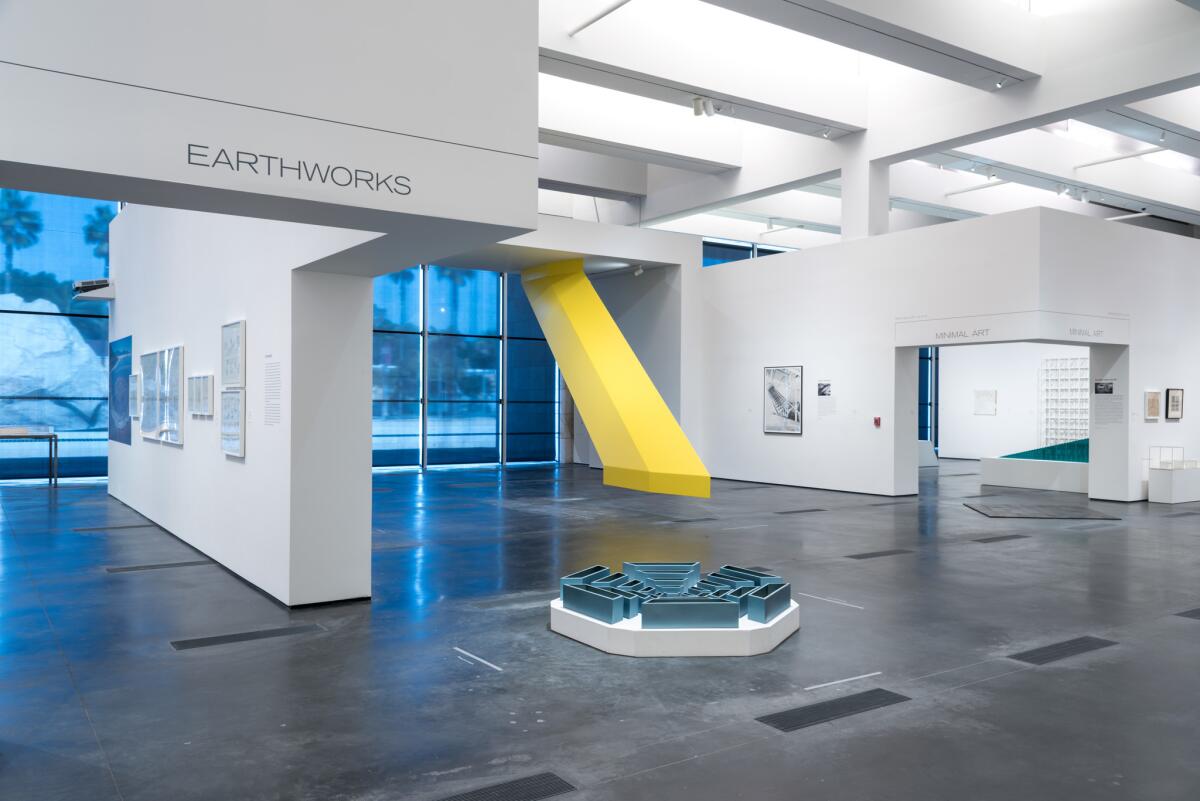Review: Where yellow means go, and go now: LACMA’s standout show on ‘60s Dwan Gallery
A nice surprise punctuates “Los Angeles to New York: Dwan Gallery, 1959-1971,” the absorbing exhibition at the
Dwan is too often overlooked in histories of postwar L.A. culture, overshadowed by the flashier Ferus Gallery that held forth on La Cienega Boulevard. This captivating show is a welcome corrective.
The surprise is Robert Grosvenor’s screaming yellow sculpture from 1966, made when the artist was 29. Shown first at Dawn, then the following year in LACMA’s important survey of “American Sculpture of the Sixties,” the painted plywood construction hasn’t been seen in 50 years.
Demolished after the museum show, the untitled work has been remade. Do not miss it.
“Untitled (yellow)” doesn’t do what Modern sculpture was supposed to do — get up off the floor, defy the mortal pull of gravity and rise heroically through space. Instead, it slices diagonally through the gallery at an oblique angle, like an improbable cross between a sunbeam and the straightened blade of a gigantic scimitar.
Did I mention that it’s screaming yellow?
Did I also mention that it does not rise from the floor? The big sculpture — it’s 24 feet long — is instead anchored to the ceiling. From there, it cantilevers out and down. Constructed something like an airplane wing, the faceted planes descend to finally hover a foot or so above the ground plane.
The thing is massive, but it feels as light as a feather. Move around it, and those faceted planes shift from wide to narrow, thick to thin. Three-dimensional mass dissolves into two-dimensional planes, which skirt the conceptual ambiguity of a line as a point moving through space. After all, just how wide must a line get before it becomes a plane?
It’s great to see the sculpture at LACMA, where Tony Smith’s monumental cellular construction, “Smoke,” occupies the Ahmanson Building’s atrium. (A fine small show of related Smith sculptures, models, drawings and documentary materials on the evolution of “Smoke” is also on view in the Ahmanson until July 2.) Smith’s 1967 work transforms the conventional stability of sculptural mass into environmental perceptual ephemerality. Grosvenor’s architectonic construction from the prior year takes another step down a sculptural road the artists shared.
And did I mention that it’s screaming yellow? In the Dwan exhibition, the color stands out amid an abundance of paintings, drawings, sculptures and mixed-media works in which neutral hues are dominant. Color wasn’t often a prominent concern in Minimal, Conceptual and Land art, which Dwan vigorously promoted.
The show was organized by James Meyer, a curator at Washington, D.C.’s National Gallery of Art, where Virginia Dwan made a bequest of about 100 works from her own collection four years ago. LACMA curator Stephanie Barron nicely beefed up the selection with more than two dozen additional works, including several from the museum’s collection.


She added labels that indicate the date and the Dwan exhibition in which the work was originally seen. Paintings and sculptures are loosely grouped by putative movement — Abstract Expressionism, Pop, Assemblage, French New Realism, Minimalism and Conceptual art.
Perhaps most important, Land artists Walter De Maria, Michael Heizer, Charles Ross and especially Robert Smithson are given considerable room. Dwan, an heiress to Minnesota’s
The fact suggests the degree to which she was less a conventional art dealer, on the prowl to make a sale, than she was a kind of high-level patron. Dwan Gallery was a place for her to explore her evolving artistic interests.
“As much as I don’t like to think of it as a money issue, I have to acknowledge the fact that I had a private income myself which made it possible for me to take a more idealistic stand, or devote myself more to the artist than perhaps a lot of other dealers would do,” she later told an interviewer from the Smithsonian’s Archives of American Art. “I knew I was going to be able to keep the doors open.”
If someone wanted to buy something, fine. Not many did. The gallery struggled, opened a branch in New York in 1965, closed in Westwood in 1967 and finally ended its Manhattan run in 1971. Through 134 exhibitions, and thanks to the new phenomenon of jet travel, Dwan became the country’s first truly bicoastal gallery. The show’s title, “Los Angeles to New York,” pointedly reverses the usual assumption of contemporary American art’s directional flow.
An introductory wall text does oddly say that Dwan was an important supporter of Los Angeles artists, although the show features mostly New York and European painters and sculptors. The big exception is Edward Kienholz.
His searing abortion tableau, “The Illegal Operation,” in which an oozing bag of wet cement slumps in a filthy shopping cart beneath a disheveled lamp’s bare bulb, plus his controversial sculpture of drunken debauchery, “Back Seat Dodge ’38,” were first shown in Westwood. (Assuming that the sculptures had their debuts at Ferus, the gallery Kienholz co-founded but left, is a common error to which I have succumbed.) Dwan’s New York outpost also opened with Kienholz — his massive walk-in assemblage of the West Hollywood diner and artists’ hang-out Barney’s Beanery, a piece in which the dealer makes an appearance.
What is important to note, however, is that Kienholz’s interactions with Dwan’s European artists had a profound impact on the L.A. sculptor’s development. His object-accumulations and alterations owe a good deal to the friendships he developed with Jean Tinguely, Arman and Yves Klein. Whenever I see the weirdly blue-flocked car that is the scene of the action in “Back Seat Dodge ’38,” I think of International Klein Blue, the textured hue that was the French artist’s trademark.

Speaking of France, did I mention that Grosvenor’s ceiling sculpture is screaming yellow? In the overwhelmingly neutral context of the black, white, gray and industrially plain works in the Dwan exhibition, the artist’s years of study in Paris (and some in Italy) between 1956 and 1959 may have had something to do with his sharp use of color.
In New York, color was becoming something of an enemy. The powerful art critic Clement Greenberg was busy promoting abstract splendor in the aptly named genre of Color Field painting. Pop art was not only brash, it was commercial. Neutral hues, by contrast, were one means of dissent, suggesting a certain purity and seriousness of purpose.
Art historian Stella Paul’s insightful new book “Chromaphilia: The Story of Color in Art” tells fascinating tales of this fundamental element throughout Western history. In her chapter on yellow, she notes that its simple yet resolute lightness on any tonal scale of dark-to-light emphatically calls attention to itself.
Whether used by Giotto, Turner, Gauguin or Albers, yellow says: Look at me.
The bright epoxy enamel on Grosvenor’s “Untitled (yellow)” lends the sense of sunlight streaming into the room through a skylight. It recalls the aureole around a mysterious and unseen holy relic — sculptural space, perhaps? — or a spotlight from overhead tracking a celebrity or surveillance subject far below. It’s a secular stairway to visual heaven and the color of a screaming standout in the LACMA show.
♦ ♦ ♦ ♦ ♦ ♦ ♦ ♦ ♦ ♦
‘Los Angeles to New York: Dwan Gallery, 1959-1971’
Where: Los Angeles County Museum of Art, 5905 Wilshire Blvd., L.A.
When: Through Sept. 10; closed Wednesdays
Information: (323) 857-6000, www.lacma.org
Twitter: @KnightLAT
MORE ART COVERAGE
LACMA plans radical change for how we see the permanent collection
Marciano art review: Foundation proves the potential and the pitfalls of a vanity art museum
Marciano architecture review: Former temple loses some personality in stylish redesign
The biggest entertainment stories
Get our big stories about Hollywood, film, television, music, arts, culture and more right in your inbox as soon as they publish.
You may occasionally receive promotional content from the Los Angeles Times.








